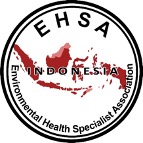Dampak Pajanan Particulate Matter 2,5 (PM2,5) Terhadap Gejala Penyakit Paru Obstruktif (PPOK) Kronis Eksaserbasi Akut pada Pekerja di Pelabuhan Tanjung Priok, 2018
Abstract
Full Text:
PDFReferences
Airnow.gov. (2018). AirNow. [online] Available at: https://airnow.gov/index.cfm?action=airnow.global_summary#Indonesia$Jakarta_South [Accessed 27 Apr. 2018].
Aqicn.org. (2018). Jakarta South (US Consulate), Indonesia Air Pollution: Real-time PM2.5 Air Quality Index (AQI). [online] Available at: http://aqicn.org/city/indonesia/jakarta/us-consulate/south/m/ [Accessed 27 Apr. 2018].
Canadian Center for Occupational Health and Safe-ty. (2017). How Do Particulates Enter the Respiratory System?. [online] Available at: https://www.ccohs.ca/oshanswers/chemicals/how_do.html [Accessed 6 Apr. 2018].
Classification of Chronic Obstructive Pulmonary Dis-ease (COPD) according to the new Global Initiative for Chronic Obstructive Lung Dis-ease (GOLD) 2017: Comparison with GOLD 2011. (2017). COPD: Journal of Chronic Ob-structive Pulmonary Disease, 15(1), pp.21-26.
CDC. (2016). CDC - Spirometry - Spirometry Train-ing Program: NHANES III Reference Values - NIOSH Workplace Safety and Health Topic. [online] Available at: https://www.cdc.gov/niosh/topics/spirometry/nhanes.html [Accessed 5 Apr. 2018].
Cukic, V., Lovre, V., Dragisic, D. and Ustamujic, A. (2012). Asthma and Chronic Obstructive Pul-monary Disease (Copd) and #8211; Differ-ences and Similarities. Materia Socio Medica, 24(2), p.100
DeMeo, D., Zanobetti, A., Litonjua, A., Coull, B., Schwartz, J. and Gold, D. (2004). Ambient Air Pollution and Oxygen Saturation. American Journal of Respiratory and Critical Care Med-icine, 170(4), pp.383-387.
DeVries, R., Kriebel, D. and Sama, S. (2016). Low level air pollution and exacerbation of existing copd: a case crossover analysis. Environ-mental Health, 15(1).
Direktorat P2PTM. (2016). Kenali Penyakit Paru Ob-struktif Kronik (PPOK) - Direktorat P2PTM. [online] Available at: http://p2ptm.kemkes.go.id/bagian/subdit-penyakit-paru-kronik-dan-gangguan-imunologi/kenali-penyakit-paru-obstruktif-kronik-ppok [Accessed 15 Apr. 2018].
Dockery, D., Pope, C., Xu, X., Spengler, J., Ware, J., Fay, M., Ferris, B. and Speizer, F. (1993). An Association between Air Pollution and Mortal-ity in Six U.S. Cities. New England Journal of Medicine, 329(24), pp.1753-1759.
Falcon-Rodriguez, C., Osornio-Vargas, A., Sada-Ovalle, I. and Segura-Medina, P. (2016). Aeroparticles, Composition, and Lung Dis-eases. Frontiers in Immunology, 7.
Fahri, I., Sutoyo, D. and Yunus, F. (2009). Efek Peradangan Sistemik Pada PPOK Terhadap Sistem Kardiovaskular. Jurnal Respilogi Indo-nesia, 29(3).
Global Initiative for Chronic Obstructive Lung Dis-ease (2017). Pocket Guide To Copd Diagno-sis, Management, And Prevention A Guide for Health Care Professionals. Global Initia-tive for Chronic Obstructive Lung Disease, p.6.
Grunig, G., Marsh, L., Esmaeil, N., Jackson, K., Gor-don, T., Reibman, J., Kwapiszewska, G. and Park, S. (2014). Perspective: Ambient Air Pollution: Inflammatory Response and Effects on the Lung's Vasculature. Pulmonary Circu-lation, 4(1), pp.25-35.
Haerul, M. (2014). Analisis Pajanan Particulate Mat-ter (PM) 2,5 pada Pekerja di Industri Pen-golahan Batu Kapur di Desa Ciampea Kabu-paten Bogor pada Tahun 2013. Undergraduate. Universitas Indonesia.
ICD-10-CM Codes (2018). 2018 ICD-10-CM Diagno-sis Code J44.1: Chronic obstructive pulmo-nary disease with (acute) exacerbation. [online] Icd10data.com. Available at: http://www.icd10data.com/ICD10CM/Codes/J00-J99/J40-J47/J44-/J44.1 [Accessed 27 Apr. 2018].
Janssen, N., Fischer, P., Marra, M., Ameling, C. and Cassee, F. (2013). Short-term effects of PM2.5, PM10 and PM2.5–10 on daily mortali-ty in the Netherlands. Science of The Total Environment, 463-464, pp.20-26.
Kementerian Kesehatan Republik Indonesia (2016). Profil Kesehatan Republik Indonesia 2013. KEMENKES RI.
Kurnia, L. and Keman, S. (2014). Analisis Risiko Pa-paran Debu PM 2,5 terhadap Kejadian Pen-yakit Paru Obstruktif Kronis pada Pekerka Bagian Boiler Perusahaan Lem di Probolinggo. Jurnal Kesehatan Lingkungan, 7(2), pp.118-125.
Li, J., Sun, S., Tang, R., Qiu, H., Huang, Q., Mason, T. and Tian, L. (2016). Major air pollutants and risk of COPD exacerbations: a systemat-ic review and meta-analysis. International Journal of Chronic Obstructive Pulmonary Disease, Volume 11, pp.3079-3091.
Marpaung, Y. (2015). Pengaruh Pajanan Debu Res-pirable PM2.5 Terhadap Kejadian Gangguan Fungsi Paru Pedagang Tetap di Terminal Terpadu Kota Depok Tahun 2012. Sarjana. Fakultas Kesehatan Masyarakat Universitas Indonesia.
Mueller, D., Uibel, S., Takemura, M., Klingelhoefer, D. and Groneberg, D. (2011). Ships, ports and particulate air pollution - an analysis of recent studies. Journal of Occupational Medi-cine and Toxicology, 6(1), p.31.
Nall, R. (2017). COPD hypoxia: Causes, symptoms, and treatment. [online] Medical News Today. Available at: https://www.medicalnewstoday.com/articles/316136.php [Accessed 25 Mar. 2018].
Ni, L., Chuang, C. and Zuo, L. (2015). Fine particu-late matter in acute exacerbation of COPD. Frontiers in Physiology, 6.
Pope III, C. (2002). Lung Cancer, Cardiopulmonary Mortality, and Long-term Exposure to Fine Particulate Air Pollution. JAMA, 287(9), p.1132.
Siahaan, E. (2012). Pengembangan Pelabuhan Berwawasan Lingkungan (Ecoport) Dalam Rangka Pengelolaan Pesisir Terpadu (Studi Kasus Pelabuhan Tanjung Priok). Master De-gree. Institut Pertanian Bogor.
U.S. Embassy & Consulates in Indonesia (2018). U.S. Embassy Jakarta Air Quality Monitor. [online] U.S. Embassy & Consulates in Indo-nesia. Available at: https://id.usembassy.gov/embassy-consulates/airqualitymonitor/ [Accessed 27 Apr. 2018].
US EPA. (2016). Particulate Matter (PM) Pollution | US EPA. [online] Available at: https://www.epa.gov/pm-pollution [Accessed 4 Apr. 2018].
US EPA (2017). National Port Strategy Assessment: Reducing Air Pollution and Greenhouse Gas-es at U.S. Ports | US EPA. [online] US EPA. Available at: https://www.epa.gov/ports-initiative/national-port-strategy-assessment-reducing-air-pollution-and-greenhouse-gases-us [Accessed 24 Mar. 2018].
Wang, H., Song, L., Ju, W., Wang, X., Dong, L., Zhang, Y., Ya, P., Yang, C. and Li, F. (2017). The acute airway inflammation induced by PM2.5 exposure and the treatment of essen-tial oils in Balb/c mice. Scientific Reports, 7,
p.44256.Mueller, D., Uibel, S., Takemura, M., Klingelhoefer, D. and Groneberg, D. (2011). Ships, ports and particulate air pollution - an analysis of recent studies. Journal of Occupa-tional Medicine and Toxicology, 6(1), p.31.
World Health Organization Europe Regional Office (2013). Health Effects of Particulate Matter. Copenhagen: WHO Regional Office for Eu-rope.
World Health Organization. (2016). Ambient (outdoor) air quality and health. [online] Avail-able at: http://www.who.int/mediacentre/factsheets/fs313/en/ [Accessed 4 Apr. 2018].
World Health Organization (2016). GHO | World Health Statistics data visualizations dash-board | Ambient air pollution. [online] GHO. Available at: http://apps.who.int/gho/data/node.sdg.11-6-viz?lang=en [Accessed 27 Apr. 2018].
Xing, Y., Xu, Y., Shi, M. and Lian, Y. (2016). The impact of PM2.5 on the human respiratory sys-tem. Journal of Thoracic Diseases, 8(I), pp.E69-E74.
Zanobetti, A., Franklin, M., Koutrakis, P. and Schwartz, J. (2009). Fine particulate air pollu-tion and its components in association with cause-specific emergency admissions. Environmental Health, 8(1).
Refbacks
- There are currently no refbacks.





